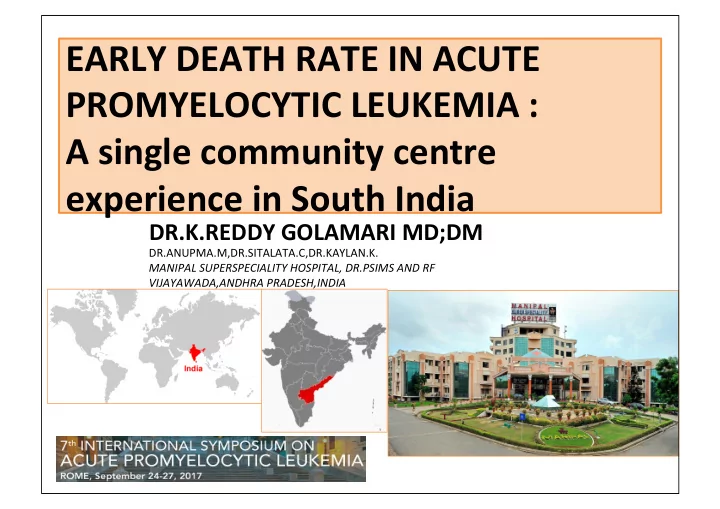

EARLY DEATH RATE IN ACUTE PROMYELOCYTIC LEUKEMIA : A single community centre experience in South India DR.K.REDDY GOLAMARI MD;DM DR.ANUPMA.M,DR.SITALATA.C,DR.KAYLAN.K. MANIPAL SUPERSPECIALITY HOSPITAL, DR.PSIMS AND RF VIJAYAWADA,ANDHRA PRADESH,INDIA
Objec7ves • To review the clinical course and treatment outcome of APL pa7ents treated at our centre
Methodology • Retrospec7ve study • Consecu7ve APL pa7ents from Jan 2013 to June 2017 included • Diagnosis was made based on CBP, bone marrow studies and PML/RAR α • Fibrinogen & counts done twice daily during first week
Results • Total AML – 204 • APML – 49 ( 24% ) 24% APML Non APML 76%
Results • PaQent CharacterisQcs Median age 25 (8-68) years Female 36,8% Males 40 (8-68) years Male 63,2% Females 21 (8-54) years <30 years 14 (54%) women 14 <16 years 7 (14.2%) 12 10 No. of patients 17-50 years 36 (73.4%) 8 6 ≥ 51 years 6 (12.2%) 4 2 0 <10 11-20 21-30 31-40 41-50 51-60 61-70 Years
Results Risk Category 6% Low 43% Intermediate 51% High • Median WBC – 10,500/mm 3 (400-1,94,500) • Median Platelet – 23,000/mm 3 (1000-90,000) • Median Hb – 7.3 gm/dl (3.3-12.5)
Results: Upfront Clinical Presenta7on Total pa7ents: 49; Upfront clinical presenta7on with complica7ons: 15 (30%) High risk:8; Intermediate risk:7 ED-11/15 Intracranial Bilateral Pulmonary Cerebro-vascular bleed (10) Pneumonia (2) haemorrhage (2) accident (1) • Intermediate • Both High • Intermediate • Intermediate risk (5) risk risk (1) risk • High risk (5) • Both • High risk (1) • Survived • Only 1 paQents • None paQent survived survived survived
Results Cause of Early Death HAEMORRHAGIC DEATH 6% 6% 6% PNEUMONIA 6% SOL BRAIN 12% FEBRILE NEUTROPENIA WITH 64% SEPSIS FEBRILE NEUTROPENIA WITH PNEUMONIA DIFFERENTIATION SYNDROME
Results Death with in 24 hours-7/17(41%) High Risk - 11 • • Intracranial bleed-5 Intermediate Risk - 6 • • Pneumonia-2 Death between 24 to 72 hours- No treatment- 8( 47% ) 4/17(23.5%) Only ATRA- 3 • Intracranial bleed-4 Protocol therapy- 6 Death a\er 72 hours-6/17(35%) • GI bleed-2 • Sol brain-1 • Febrile neutropenia with sepsis-1 • Febrile neutropenia with pneumonia-1 • Differen7a7on syndrome-1
Baseline characteristics: ED versus Non ED groups Character ED: 17 (34.6%) NON ED: 32 (65.3%) P -VALUE Age (in years) 40 (8-61) 26 (14-68) NS Median (IQR) Female 5 (29.4%) 13 (40.6%) NS Male 12 (70.5%) 19 (59.3%) Low risk 0 (0%) 3 (9.4%) Intermediate risk 6 (35.3%) 15 (46.8%) NS High risk 11 (64.7%) 14 (43.8%) WBC count (mm 3 ) 17500 (400 -194500) 7000 (400 - 106000) 0.09 Platelet count (mm 3 ) 11,500 (1000 - 51000) 24000 (3000 - 90000) 0.03
Baseline characteris7cs: ED versus Non ED groups Character ED NON ED P - VALUE (n = 17) (n= 32) Hb (gm/dl) 7.6 (3.3-10.3) 6.8 (3.6-12.5) NS Fever 14 (82.3%) 26 (81.3%) NS DuraQon from 10.0 (7.0, 25.0) 10.0 (6.75, 22.0) NS symptom onset to reporQng to hospital (in days) Median(IQR) Ini7a7on of ATRA < 9/11 (81.8%) 30/32 (93.8%) NS 24 hours PS 3 OR 4 11(64.7%) 3(9.3%) 0.01
ED Rate-Treatment regimen wise ATRA+ARSENIC TRIOXIDE ATRA+CHEMOTHERAPY 2 2 10 HIGH RISK INTERMEDIATE RISK LOW RISK 14 9 Death: 1 pa7ent Death: 5 pa7ents • Non protocol ED- 11 paQents • Only ATRA- 3 • No treatment- 8
Outcomes • Total evaluable pa7ents- 38 • Haematological remission achieved - 32(84.2%) • Death aier 72 hours aier admission- 6(15.7%) • One pa7ent lost to follow up • One pa7ent- relapse
Survival data All paQents Non ED pts p = 0.297
Comparison with other studies Our study Brazil Stanford Sweden Canada NO OF PATIENTS 49 157 70 105 300 MEDIAN AGE YEARS 25(8-68) 36(5-79) 50(19-93) 54 (18-86) 47.9(7-85) FEMALE/MALE(%) 37/63 55/45 63/37 65/40 49/51 HIGH RISK( %) 51 36.9 35 41 20.6 INTERMEDIATE 43 44.6 47 35 50.4 RISK(%) LOW RISK(%) 6 18.5 19 23 26 EARLY DEATH RATE(%) 34.6 26.4 26 29 21.8 HEMORRHAGIC 64.7 60.5 54 41 DEATH(%) NO ANTILEUKEMIC RX 47 16.6 21 AMONG ED(%) Lehmann S, Leukemia. 2011 Jul 1;25(7):1128. McClellan JS ,Haematologica. 2012 Jan 1;97(1): 133-6. Jácomo RH ,Haematologica. 2007 Oct 1;92(10):1431-2. Paulson K , British journal of haematology. 2014 Sep 1;166(5):660-6.
Conclusions • ED during the treatment of APL remains a major challenge despite improved treatment op7ons and suppor7ve measures • A younger age at diagnosis , presence of high propor7on of high risk paQents and lower number of low risk pa7ents as contributors to ED needs to be inves7gated • Increasing awareness among primary health care physicians about the diagnosis of APL, and ensuring quick referral to a ter7ary centre with exper7se in the treatment of this uncommon yet curable malignancy will go a long way in achieving bener outcomes •
Thank you
Recommend
More recommend